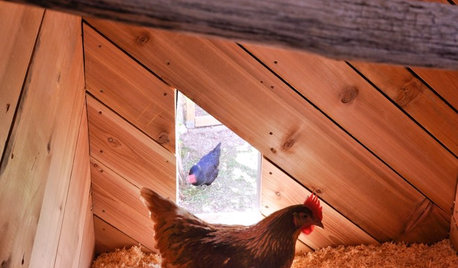Please Help Me With Sick Hens
kobuknulu
14 years ago
Related Stories

LIFE10 Feel-Better Things to Do on a Sick Day at Home
Nourish, pamper and heal yourself when a cold keeps you housebound, with these restorative ideas
Full Story
HOME OFFICESQuiet, Please! How to Cut Noise Pollution at Home
Leaf blowers, trucks or noisy neighbors driving you berserk? These sound-reduction strategies can help you hush things up
Full Story
GARDENING GUIDESGreat Design Plant: Hens-and-Chicks
Plant Sempervivum succulents for fuss-free garden color and character all year
Full Story
PETSHens Nest in Style in a Modern Nevada Coop
Take a mini tour of a backyard chicken coop built by a pro designer with all the essentials for the 'clients' and then some
Full Story
GARDENING GUIDESPathway Plantings That Please the Senses
Add some color, life and intrigue beside your sidewalk with these 7 suggestions
Full Story
ORGANIZINGDo It for the Kids! A Few Routines Help a Home Run More Smoothly
Not a Naturally Organized person? These tips can help you tackle the onslaught of papers, meals, laundry — and even help you find your keys
Full Story
KITCHEN DESIGNDesign Dilemma: My Kitchen Needs Help!
See how you can update a kitchen with new countertops, light fixtures, paint and hardware
Full Story
HOUSEKEEPINGWhen You Need Real Housekeeping Help
Which is scarier, Lifetime's 'Devious Maids' show or that area behind the toilet? If the toilet wins, you'll need these tips
Full Story
COLORPick-a-Paint Help: How to Quit Procrastinating on Color Choice
If you're up to your ears in paint chips but no further to pinning down a hue, our new 3-part series is for you
Full Story






nhsuzanne
Naomi Miller
Related Professionals
New Bedford Landscape Architects & Landscape Designers · Havre de Grace Landscape Architects & Landscape Designers · Milwaukee Landscape Architects & Landscape Designers · Berwyn Landscape Contractors · Cornelius Landscape Contractors · Fridley Landscape Contractors · Miller Place Landscape Contractors · New Brighton Landscape Contractors · Ramsey Landscape Contractors · Ringwood Landscape Contractors · Rockland Landscape Contractors · Tamarac Landscape Contractors · Ferguson Landscape Contractors · Commerce City Decks, Patios & Outdoor Enclosures · Richmond Decks, Patios & Outdoor Enclosuresvelvet_sparrow